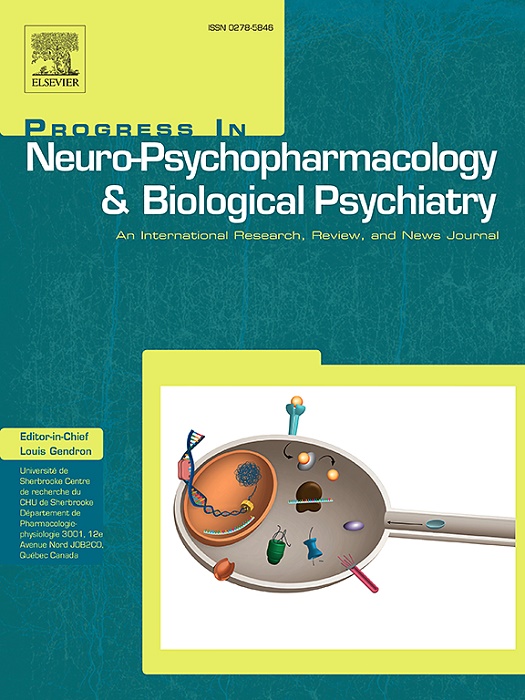与创伤后应激障碍相关的内源性大麻素和炎症标志物的性别差异。
IF 3.9
2区 医学
Q1 CLINICAL NEUROLOGY
Progress in Neuro-Psychopharmacology & Biological Psychiatry
Pub Date : 2025-09-16
DOI:10.1016/j.pnpbp.2025.111501
引用次数: 0
摘要
创伤后应激障碍(PTSD)是一种严重的精神障碍,主要影响女性,其特征是炎症加剧和应激缓冲内源性大麻素系统紊乱。然而,这些改变是否对男性和女性的创伤后应激障碍病理生理有影响在很大程度上是未知的。本病例对照研究在创伤后应激障碍患者和非精神病学对照组中检测了循环内源性大麻素(eCBs)和促炎标志物水平的性别差异。88名PTSD患者和85名性别和年龄匹配的健康对照(hc)回顾性地从麻省总医院布里格姆生物样本库中选择。检测血清样本中eCBs [n-花生四烯酰基乙醇胺(AEA)、2-花生四烯酰基甘油(2-AG)、油基乙醇酰胺(OEA)和花生四烯酸(AA)]和促炎标志物[白细胞介素-1β (IL-1β)、IL-6、IL-8、IL-18、肿瘤坏死因子-α (TNF-α)和c反应蛋白(CRP)]的循环水平。我们的结果显示基于性别和PTSD诊断的不同分子图谱。与男性对照组相比,男性PTSD患者表现出AEA、AA和OEA水平下降(p's)本文章由计算机程序翻译,如有差异,请以英文原文为准。
Sex differences in endocannabinoid and inflammatory markers associated with posttraumatic stress disorder
Posttraumatic stress disorder (PTSD), a severe psychiatric disorder that predominantly affect women, is characterized by heightened inflammation and perturbations of the stress-buffering endocannabinoid system. However, whether these alterations contribute to PTSD pathophysiology in both men and women is largely unknown. This case-control study examined sex-differences in circulating levels of endocannabinoids (eCBs) and pro-inflammatory markers in a cohort of individuals with PTSD and non-psychiatric controls.
Eighty-eight patients with PTSD and 85 sex- and age- matched healthy controls (HCs) were retrospectively selected from the Mass General Brigham Biobank. Serum samples were assayed to measure circulating levels of eCBs [N-arachidonoylethanolamine (AEA), 2-arachidonoylglycerol (2-AG), oleoylethanolamide (OEA), and arachidonic acid (AA)] and pro-inflammatory markers [interleukin-1β (IL-1β), IL-6, IL-8, IL-18, tumor necrosis factor-alpha (TNF-α), and C-reactive Protein (CRP)].
Our results showed distinct molecular profiles based on sex and PTSD diagnosis. Male PTSD patients exhibited decreased levels of AEA, AA and OEA compared to both male controls (p's < 0.001 to 0.05) and to the female subgroups (PTSD and HCs) (p < 0.01). In contrast, female PTSD patients showed elevated levels of IL-6 and IL-8 compared to the other subgroups (p's < 0.010), although only a trend-level effect in IL-6 levels persisted when examining the magnitude of group differences (PTSD vs HCs) across sexes. Similar results were obtained after controlling for the FAAH 385 A genotype and in the subgroup of individuals with comorbid MDD.
These findings suggest that distinct neurobiological mechanisms may underlie PTSD in men and women and highlight the need for sex-based therapeutic approaches.
求助全文
通过发布文献求助,成功后即可免费获取论文全文。
去求助
来源期刊
CiteScore
12.00
自引率
1.80%
发文量
153
审稿时长
56 days
期刊介绍:
Progress in Neuro-Psychopharmacology & Biological Psychiatry is an international and multidisciplinary journal which aims to ensure the rapid publication of authoritative reviews and research papers dealing with experimental and clinical aspects of neuro-psychopharmacology and biological psychiatry. Issues of the journal are regularly devoted wholly in or in part to a topical subject.
Progress in Neuro-Psychopharmacology & Biological Psychiatry does not publish work on the actions of biological extracts unless the pharmacological active molecular substrate and/or specific receptor binding properties of the extract compounds are elucidated.

 求助内容:
求助内容: 应助结果提醒方式:
应助结果提醒方式:


